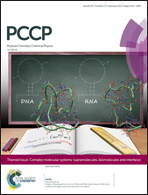Mechanical stability of a nanotube from monolayer black phosphorus with the [110] direction as the tube's circumference or generatrix†
Abstract
The mechanical properties of black phosphorus (BP) are anisotropic. Correspondingly, the properties of the nanotubes formed by bending the same BP ribbon along different directions are different as well. When bending the ribbon along the [110] direction (i.e., stair direction), or along its perpendicular direction (i.e., ps-direction), s- or ps-BPNT can be obtained. The two types of BPNTs are investigated via molecular dynamics (MD) simulations on their thermal and mechanical properties. The results indicate that, for the thermal stability of the s-BPNTs with similar diameters, s-BPNT is weaker than a-BPNTs (armchair type) but stronger than ps-BPNT, and z-BPNT (zigzag type) is the weakest one. In general, a-BPNT has larger compressive or tensile strength, while s-BPNT and ps-BPNT can bear larger deformation. Under uniaxial compression, s-BPNT has two different breaking patterns at different temperatures. The peculiar properties illustrate the wider application of BPNTs in nanodevices under large deformation.
![Graphical abstract: Mechanical stability of a nanotube from monolayer black phosphorus with the [110] direction as the tube's circumference or generatrix](/en/Image/Get?imageInfo.ImageType=GA&imageInfo.ImageIdentifier.ManuscriptID=C7CP07662B&imageInfo.ImageIdentifier.Year=2018)


 Please wait while we load your content...
Please wait while we load your content...